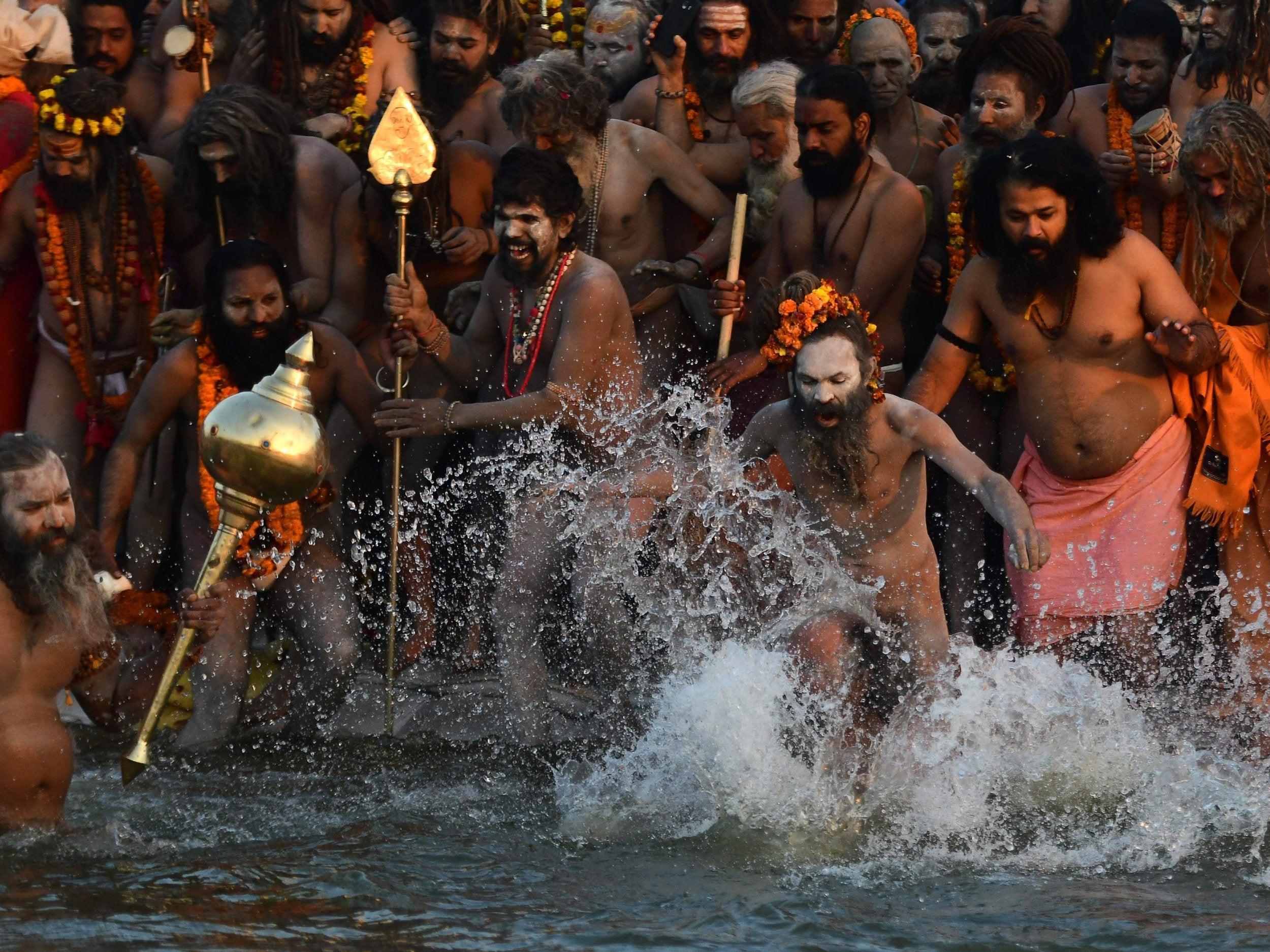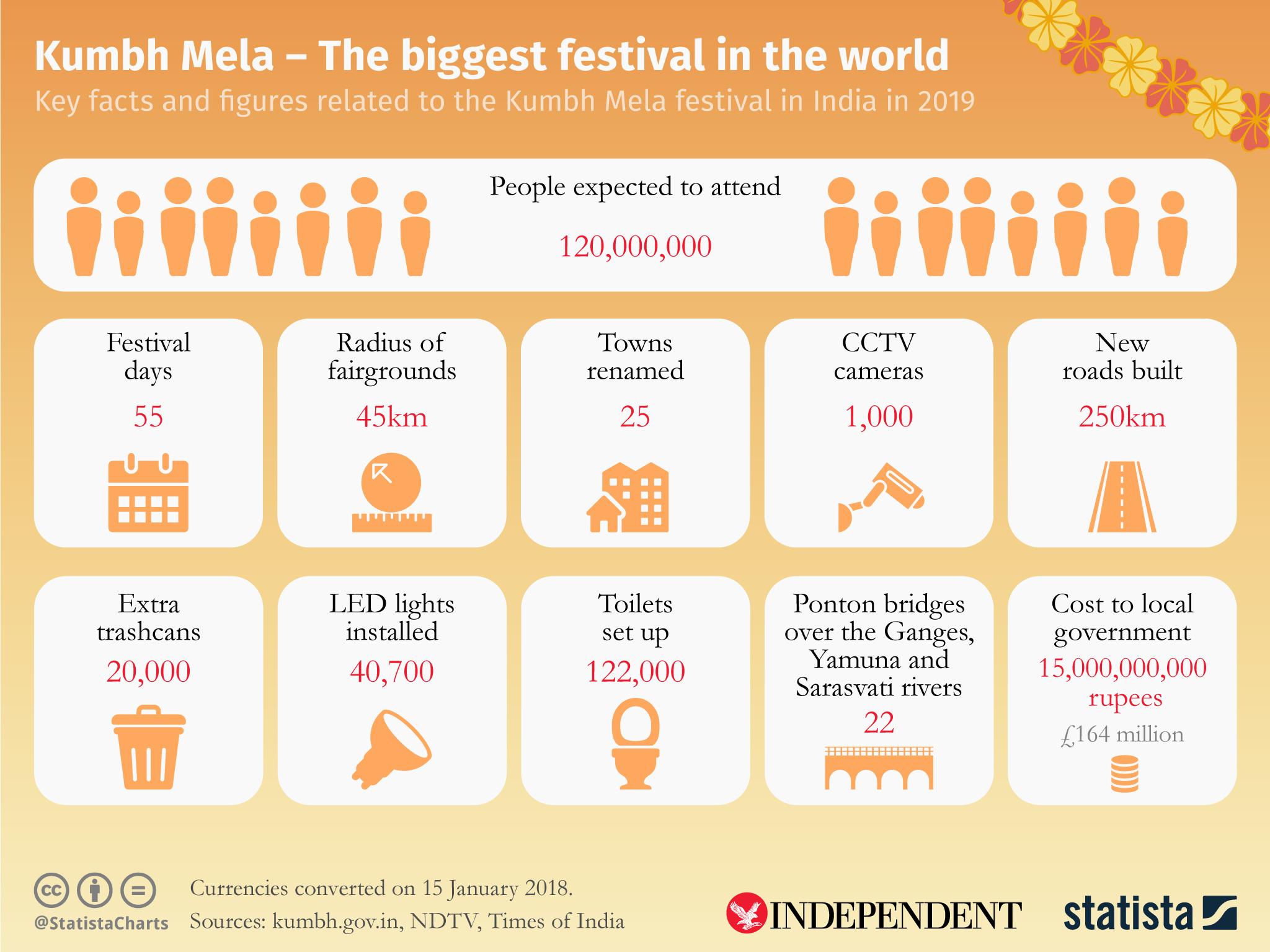Kumbh Mela: World's largest gathering of people begins in India
Festival sees Hindus renew themselves with a dip at the confluence of three holy rivers

The largest gathering of people anywhere in the world began in India on Tuesday, as thousands of pilgrims bathed in waters at the confluence of the country’s most sacred rivers – the Ganges, the Yamuna and the dried-up Sarasvati.
Over the course of the 55 days of the Kumbh Mela festival, organisers estimate that the number of bathers will surpass the record attendance of 120 million set in 2013.
Such a gathering has been a major undertaking for both local and central governments, and – with a general election looming in a few months’ time – has received particular attention from the ruling Hindu nationalist BJP party of Narendra Modi.
The festival sees Hindus renew themselves with a dip in the Sangam, the confluence – a site which rotates between four locations every three years.
This year, the main gathering is taking place in Prayagraj, a city that was renamed recently from Allahabad by a state government keen to emphasise the country’s Hindu heritage over its period of Muslim rule under the Mughal emperors.
And the state’s religious affairs minister, Laxmi Narayan Chaudhary, claimed that it was the first time “since independence” that all the holy men and pilgrims attending Kumbh Mela had been properly catered for.
For though this year’s Kumbh is less religiously significant than the one which occurs every twelfth year, the government has shelled out an estimated 43 billion rupees (£500m), hoping to impress and energise Hindu voters as well as draw visitors from around the world.
Thousands of portable toilets lined roads that were constantly swept clean on Tuesday, drinking water flowed from newly installed taps and electric substations powered a massive tent city as the festival area spread to a sprawling 45km diameter.
The spectacle began in earnest before dawn, with the first in a series of holy baths led by the iconic naga sadhus – holy men who made their way down to the river naked, their bodies covered in ash

The Kumbh Mela is yet to draw tourists or international attention in the same way as some other Hindu festivals. Nonetheless, there were foreign visitors among the gathered crowds.
“It is surreal,” said Manuel Matthaus, from Germany, of the ash-covered holy men. I had always heard about them,” he told the Hindu newspaper, describing them as “one of the reasons we wanted to come to the Kumbh”.
“I did plan to take the bath,” he added. “But I guess the water now is too freezing for my linking. Maybe later in the evening.”

One concern for international visitors will be the environmental conditions at the festival site. A thick haze of toxic dust hung over Prayagraj for the start of festivities, according to the Associated Press, and PM 2.5 levels were measured at more than six times the World Health Organisation’s safe limit.
The dust plumes encompassing the camp came from the sandy riverbanks, said city commissioner Ashish Goel, and not from construction, which has been banned for the duration of the seven-week festival.
Nonetheless, they highlight the struggle the central government faces in tackling India’s air pollution crisis. Also this week, Mr Modi’s government has unveiled its plan to clean up the country’s air – but allocated just 3 billion rupees (£33m) to the cause over the next two years, less than a tenth of the cost of the festival itself.
Kumbh Mela draws pilgrims from across the socio-economic spectrum, with accommodation options stretching up to luxury “glamping” tents costing some £400 a night.
But with the scale of expenditure, this year's public provisions were at an unprecedented level.
"I go to holy sites very often, but I'm used to them being very dirty. I have never seen this level of cleanliness measures at any other holy city," said Gita Mishra, 58, one of the guests at a public tent near the banks of the river.
Mili Mishra, a teacher from Prayagraj who was with her husband and two sons, said: "We are not earning a livelihood. We think that if we bathe here, God can change our life.”
Join our commenting forum
Join thought-provoking conversations, follow other Independent readers and see their replies
Comments
Bookmark popover
Removed from bookmarks